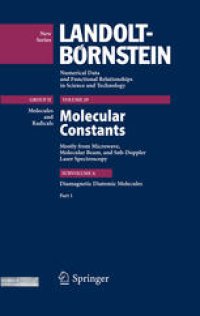
Ebook: Diamagnetic Diatomic Molecules. Part 1
- Genre: Chemistry
- Tags: Physics general, Atomic/Molecular Structure and Spectra
- Series: Landolt-Börnstein - Group II Molecules and Radicals 29A1 : Molecules and Radicals
- Year: 2012
- Publisher: Springer-Verlag Berlin Heidelberg
- Edition: 1
- Language: English
- pdf
Volume II/29 "Molecular Constants Mostly from Microwave, Molecular Beam, and Sub-Doppler Laser Spectroscopy" is planned to appear as a series A1, A2, B, C and D1, D2, D3 for the diamagnetic, and E for the paramagnetic linear and polyatomic species, respectively.
Like in the preceding volumes II/24 and II/19, which have appeared in the years around 1999 and 1992, respectively, the diamagnetic substances are arranged in the manner suggested by Hill ("Hill's system", 1900), meaning an almost strict alphabetical order. The ionic species are included in the alphabetical arrangement of the neutral ones in each table.
The information is grouped differently in comparison with the previous volumes. All relevant properties of a molecule and the corresponding parameters can be found concentrated under its sum formula in volume II/29. This diminishes the need of turning pages because rotational and related constants, dipole moments, barriers to internal rotation, hyperfine coupling parameters, or Zeeman data were hitherto listed in different tables.
The present subvolume II/29A1 contains data for diatomic diamagnetic molecules.
Volume II/29 "Molecular Constants Mostly from Microwave, Molecular Beam, and Sub-Doppler Laser Spectroscopy" is planned to appear as a series A1, A2, B, C and D1, D2, D3 for the diamagnetic, and E for the paramagnetic linear and polyatomic species, respectively.
Like in the preceding volumes II/24 and II/19, which have appeared in the years around 1999 and 1992, respectively, the diamagnetic substances are arranged in the manner suggested by Hill ("Hill's system", 1900), meaning an almost strict alphabetical order. The ionic species are included in the alphabetical arrangement of the neutral ones in each table.
The information is grouped differently in comparison with the previous volumes. All relevant properties of a molecule and the corresponding parameters can be found concentrated under its sum formula in volume II/29. This diminishes the need of turning pages because rotational and related constants, dipole moments, barriers to internal rotation, hyperfine coupling parameters, or Zeeman data were hitherto listed in different tables.
The present subvolume II/29A1 contains data for diatomic diamagnetic molecules.